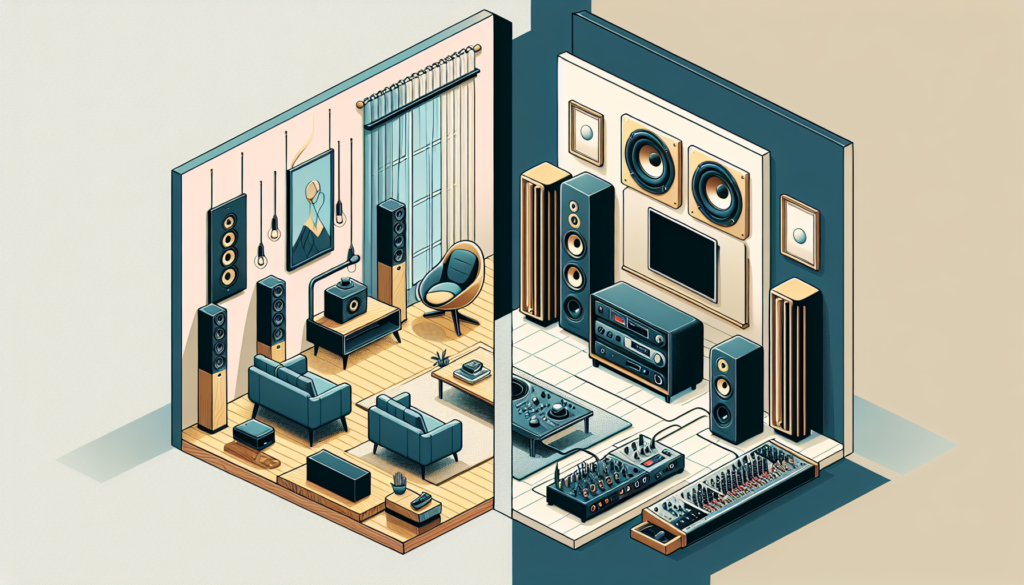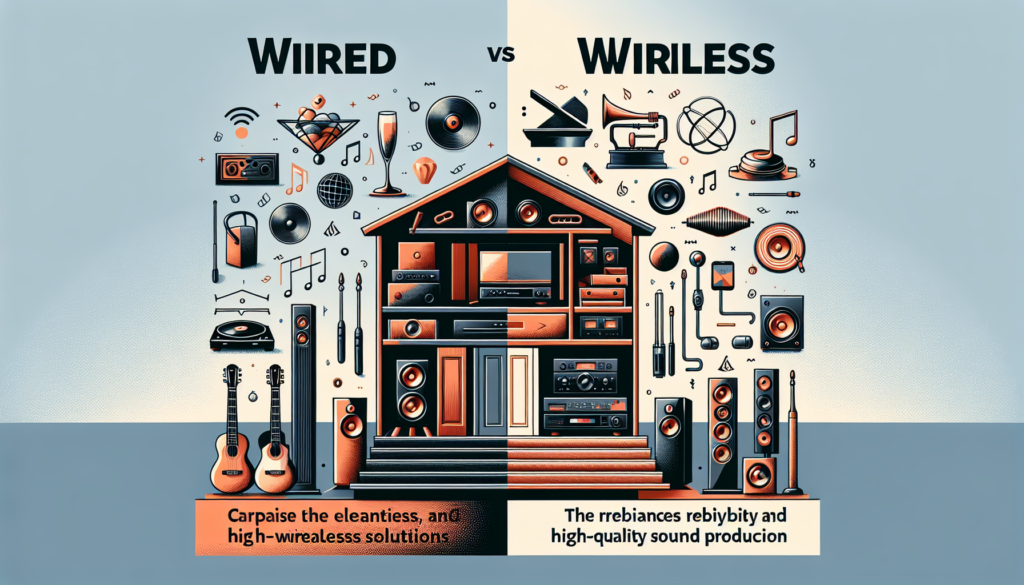Are you tired of tangled wires and limited mobility when it comes to your home audio system? Look no further! In this article, we will explore the pros and cons of wireless and wired solutions for your home audio needs. Whether you value convenience or sound quality, we’ve got you covered. So grab your favorite beverage and let’s dive into the world of home audio systems!
Introduction
When it comes to setting up a home audio system, there are two main options to consider: wireless and wired solutions. Both options have their own set of advantages and disadvantages, and choosing the right one for your needs can be a daunting task. In this article, we will explore the different aspects of wireless and wired home audio systems to help you make an informed decision. From sound quality and range to cost and scalability, we will cover it all.
Wireless Home Audio Systems
Overview of wireless home audio systems
Wireless home audio systems, as the name suggests, allow you to stream audio wirelessly from various devices such as smartphones, tablets, and computers to speakers placed throughout your home. These systems typically use Wi-Fi or Bluetooth technology to transmit the audio signal. They offer convenience and flexibility, allowing you to easily control and manage your audio playback from anywhere within range.
Advantages of wireless home audio systems
One of the biggest advantages of wireless home audio systems is the freedom of mobility they provide. Since there are no physical cables involved, you can move your speakers and other audio devices around your home without any hassle. Additionally, wireless systems often come with mobile apps or remote control options, enabling you to adjust the volume and playback settings with ease.
Disadvantages of wireless home audio systems
While wireless home audio systems offer convenience, they do come with a few downsides. The first major drawback is the potential for interference. Wi-Fi signals can be affected by other devices or obstructions in the home, leading to a loss in audio quality or disruptions in connectivity. Additionally, wireless systems may have limited range, especially if you have a large home or want to extend the audio coverage to outdoor areas.

Wired Home Audio Systems
Overview of wired home audio systems
Unlike wireless systems, wired home audio systems rely on physical connections between components. This means that you will need to run cables from your audio sources to your speakers or amplifiers. While this may seem less convenient at first, wired systems offer their own benefits in terms of sound quality and reliability.
Advantages of wired home audio systems
One of the main advantages of wired home audio systems is the superior sound quality they provide. Since the audio signal travels through cables, there is minimal loss or interference, resulting in cleaner and more accurate reproduction of music or other audio content. Wired systems also tend to have a longer range, making them suitable for larger homes or outdoor installations.
Disadvantages of wired home audio systems
The main disadvantage of wired home audio systems is the complexity of installation. Running cables across your home can be a time-consuming and labor-intensive process, especially if you want to have audio in multiple rooms. Additionally, once the cables are in place, it can be difficult to rearrange your audio setup or move components around without dedicating additional time and effort.
Sound Quality
Comparing sound quality of wireless and wired home audio systems
When it comes to sound quality, wired home audio systems have the upper hand. The physical connections allow for a direct and undisturbed transmission of the audio signal, resulting in cleaner and more accurate sound reproduction. Wireless systems, on the other hand, may experience signal loss or interference, leading to potential degradation of sound quality.
Factors affecting sound quality
In both wireless and wired systems, several factors can affect the overall sound quality. One such factor is the audio source itself. High-quality audio files or streaming services with higher bitrates will generally result in better sound quality. Another factor is the speakers or headphones you use. Investing in high-quality audio equipment can significantly enhance the sound experience, regardless of whether you choose a wireless or wired system.
Audio formats and compatibility
When considering sound quality, it is important to think about audio formats and compatibility. Most wireless home audio systems support popular audio formats such as MP3, AAC, and FLAC. However, some formats or high-resolution audio files may not be supported by all systems. With wired systems, you have more flexibility in terms of audio formats, as they can support a wider range of formats without any limitations.

Setup and Installation
Ease of setup and installation for wireless home audio systems
One of the major advantages of wireless home audio systems is their ease of setup and installation. With no cables to worry about, you can simply connect your wireless speakers or devices to your Wi-Fi network and start streaming music. Many wireless systems come with user-friendly apps or interfaces that guide you through the setup process, making it quick and hassle-free.
Complexity of setup and installation for wired home audio systems
On the other hand, wired home audio systems require more effort and planning during the setup and installation process. Running cables and hiding them can be a challenge, especially if you want a clean and tidy appearance. You may need to drill holes, use cable management solutions, or seek professional help for a seamless installation. However, once the system is set up, it generally requires less maintenance and troubleshooting compared to wireless systems.
Compatibility with existing devices and infrastructure
When setting up your home audio system, it is essential to consider compatibility with your existing devices and infrastructure. Wireless systems usually offer more flexibility in this regard, as they can connect to a wide range of devices using Wi-Fi or Bluetooth. With wired systems, you will need to ensure that your audio sources have the necessary connectors or adapters to connect to your amplifier or speakers.
Range and Coverage
Wireless range limitations for home audio systems
Wireless home audio systems typically have a limited range, especially when using Wi-Fi or Bluetooth technology. This can be a significant drawback if you want to have audio coverage throughout your entire home or extend it to outdoor areas. The range may vary depending on factors such as the strength of your Wi-Fi signal, the presence of obstacles like walls or furniture, and interference from other wireless devices.
Expanded coverage options with wired home audio systems
Wired home audio systems, on the other hand, offer expanded coverage options. Since you can run cables to different rooms or areas, you can easily have speakers in each of these locations, providing a seamless audio experience. This is particularly beneficial if you have a larger home or want to create a dedicated home theater setup with surround sound.
Obstacles and interference
Both wireless and wired home audio systems can face obstacles and interference that affect the range and coverage. In wireless systems, obstacles such as walls, floors, or even other electronic devices can weaken the signal and reduce the range. Wired systems, although not as susceptible to interference, may encounter limitations due to the length of the cables or the quality of connections.
Flexibility and Mobility
Portability and mobility advantages of wireless home audio systems
Wireless home audio systems offer a significant advantage in terms of portability and mobility. With no physical cables tying you down, you can easily move speakers or audio devices around the house to suit your preferences. For example, if you are hosting a party, you can relocate your wireless speakers to the living room or patio for a more immersive sound experience.
Limitations of wired home audio systems for flexibility
In contrast, wired home audio systems have limitations when it comes to flexibility and mobility. Once the cables are installed, moving speakers or components can be challenging and time-consuming. This lack of flexibility can be a disadvantage if you frequently rearrange your furniture or plan to expand your audio setup in the future.
Multi-room audio capabilities
Both wireless and wired home audio systems offer multi-room audio capabilities, although they may differ in terms of implementation. Wireless systems often come with dedicated apps or software that allow you to synchronize and control audio playback across multiple rooms. Wired systems, on the other hand, require a separate amplifier or receiver for each room, but they can provide a more seamless and synchronized audio experience.
Cost and Scalability
Cost considerations for wireless home audio systems
When it comes to cost, wireless home audio systems can vary significantly depending on the brand, features, and number of speakers you require. While there are affordable options available, high-end wireless systems can be quite expensive. Additionally, bear in mind that you may need to purchase multiple speakers or devices to achieve the desired audio coverage throughout your home.
Scalability options of wireless home audio systems
Wireless home audio systems generally offer good scalability options, allowing you to add more speakers or devices as needed. Many wireless systems support multi-room audio and can be expanded by simply adding additional speakers to different rooms. However, be aware that adding more speakers may impact your Wi-Fi network performance, especially if you have a large number of devices connected simultaneously.
Comparing costs and scalability of wired home audio systems
Wired home audio systems typically have a higher upfront cost due to the need for cables, connectors, and amplifiers. However, once the initial setup is complete, adding additional speakers or components is relatively straightforward and cost-effective. Additionally, wired systems generally do not require an extensive Wi-Fi network, making them a more scalable option for larger setups or homes with multiple audio zones.
Reliability and Stability
Stability and reliability of wireless home audio systems
Wireless home audio systems can offer good stability and reliability, but they are not immune to potential issues. Wi-Fi or Bluetooth signals can sometimes be affected by interference, leading to dropouts or interruptions in audio playback. Network congestion can also be a concern if you have many devices connected to your Wi-Fi network simultaneously. However, with proper network optimization and equipment placement, these issues can be mitigated.
Consistency and stability of wired home audio systems
In terms of consistency and stability, wired home audio systems have the upper hand. The physical connections ensure a secure and reliable transmission of the audio signal, with minimal chances of dropouts or interruptions. As long as the cables are properly installed and maintained, you can expect a consistent and stable audio experience.
Effects of network congestion and interruptions
While wired home audio systems are not directly affected by network congestion or interruptions, they may still rely on other network components such as streaming services or online content. If your wired system is connected to the internet for streaming music or accessing online resources, network congestion or interruptions can impact your overall audio experience. It is essential to consider these factors when planning and setting up your home audio system.
Conclusion
In the battle between wireless and wired home audio systems, there is no one-size-fits-all solution. Each option has its own strengths and weaknesses, and the right choice ultimately depends on your personal preferences and requirements. Wireless systems offer convenience, mobility, and scalability, but may suffer from potential interference or limited range. On the other hand, wired systems provide superior sound quality, reliability, and stability, but require more effort and planning during installation. Consider your budget, setup complexity, audio quality preferences, and future scalability needs when making your decision. With the right system in place, you can enjoy immersive and high-quality audio throughout your home for years to come.

